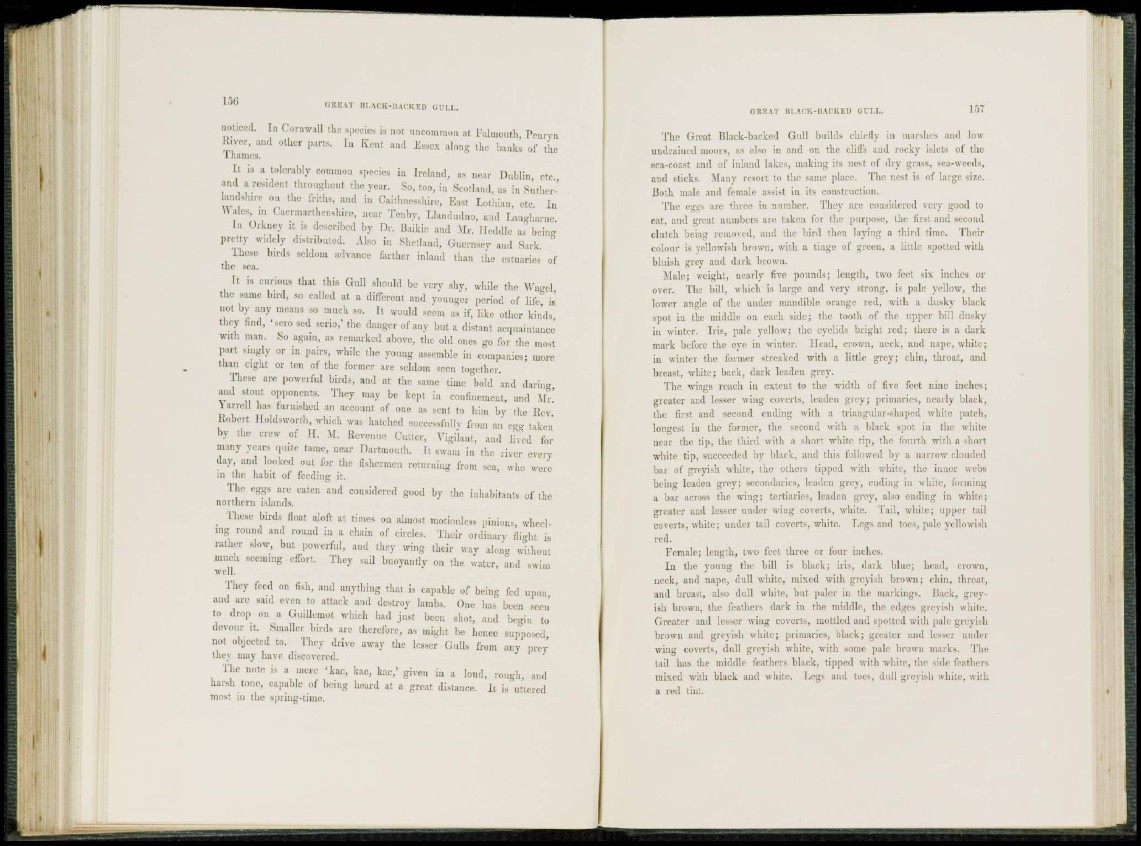
156 GREAT BLACK-BACKED GULL,
noticed. In Cornwall the species is not uncommon at Falmouth, Pcnryn
River, and other parts. In Kent and Essex along the banks of the
Thames.
I t is a tolerably common species in Ireland, as near Dublin, etc.,
and a resident throughout the year. So, too, in Scotland, as in Sutherlandshire
on the friths, and in Caitlmesshire, East Lothian, etc. In
Wales, in Carmarthenshire, near Tenby, Llandudno, and Laugharne.
In Orkney it is described by Dr. Baikie and Air. Heddle as being
pretty widely distributed. Also in Shetland, Guernsey and Sark.
These birds seldom advance farther inland than the estuaries of
the sea.
11 is curious that this Gull should be very shy, while the Wagel,
the same bird, so called at a different and younger period of life, is
not by any means so much so. It would seem as if, like other kinds,
they find, 'sero sed serin,' the danger of any but a distant acquaintance
with man. So again, as remarked above, the old ones go for the most
part singly or in pairs, while the young assemble in companies; more
than eight or ten of the former are seldom seen together.
These are powerful birds, and at the same time bold and daring,
and stout opponents. They may be kept in confinement, and Mr.
Varrell has furnished an account of one as sent to him by the Rev.
Robert Holdsworth, which was hatched successfully from an egg taken
by the crew of II. M. Revenue Cutter, Vigilant, and lived for
many years quite tame, near Dartmouth. It swam in the river every
day, and looked out for the fishermen returning from sea, who were
in the habit of feeding it.
The eggs are eaten and considered good by the inhabitants of the
northern islands.
These birds float aloft at times on almost motionless pinions, wheeling
round and round in a chain of circles. Their ordinary flight is
rather slow, but powerful, and they wing their way along without
much seeming effort. They sail buoyantly on the water, and swim
well.
They feed on fish, and anything that is capable of being fed upon,
and are said even to attack and destroy lambs. One has been seen
to drop on a Guillemot which had just been shot, and begin to
devour it. Smaller birds are therefore, as might be hence supposed,
not objected to. They drive away the lesser G nils from any prey
the\ may have discovered.
The note is a mere 'kac, kac, kac,' given in a loud, rough, and
harsh tone, capable of being heard at a great distance. It is uttered
most in the spring-time.
ORE AT H T, A (' K - It A C K E D GULL.
The Great Tilack-backcd Gull builds chiefly in marshes and low
undrained moors, as also in and on the cliffs and rocky islets of the
sea-coast and of inland lakes, making its nest of dry grass, sea-weeds,
and sticks. Many resort to the same place. The nest is of large size.
Uoth male and female assist in its construction.
The eggs are three in number. They are considered very good to
eat, and great numbers are taken for the purpose, the first and second
clutch being removed, and the bird then laying a third time. Thencolour
is yellowish brown, with a tinge of green, a little spotted with
bluish grey and dark brown.
Male; weight, nearly five pounds; length, two feet six inches or
over. The bill, which is large and very strong, is pale yellow, the
lower angle of the under mandible orange red, with a dusky black
spot in the middle on each side; the tooth of the upper bill dusky
in winter. Iris, pale yellow; the eyelids bright reel; there is a dark
mark before the eye in winter. Head, crown, neck, and nape, white;
in winter the former sireaked with a little grey; chin, throat, and
breast, white; back, dark leaden grey.
The wings reach in extent to the width of five feet nine inches;
greater and lesser wing coverts, leaden grey; primaries, nearly black,
the first and second ending with a triangular-shaped white patch,
longest in the former, the second with a black spot in the white
near the tip, the third with a short white tip, the fourth with a short
white tip, succeeded by black, and this followed h\" a narrow clouded
bar of greyish white, the others tipped with white, the inner webs
being leaden grey; secondaries, leaden grey, ending in white, forming
a bar across the wing; tertiarics, leaden grey, also ending in white;
greater and lesser under wing coverts, white. Tail, white; upper tail
coverts, white; under tail coverts, white. Legs and toes, pale yellowish
red.
Female; length, two feet three or four inches.
I n the young the bill is black; iris, dark blue; head, crown,
neck, and nape, dull white, mixed with greyish brown; chin, throat,
and breast, also dull white, but paler in the markings. Hack, greyish
brown, the feathers dark in the middle, the edges grevish white.
Greater and lesser wing coverts, mottled and spotted with pale greyish
brown and greyish white; primaries, black; greater and lesser under
wing coverts, dull greyish white, with some pale brown marks. The
tail has the middle feathers black, tipped with white, the side feathers
mixed with black and white. Legs and toes, dull greyish white, with
a red tint.